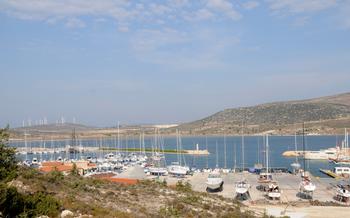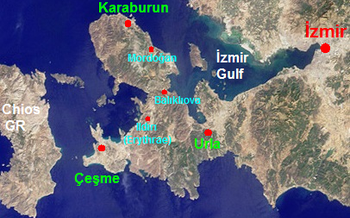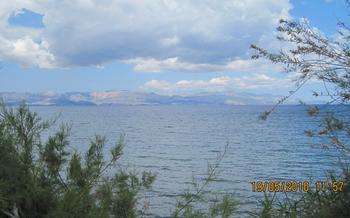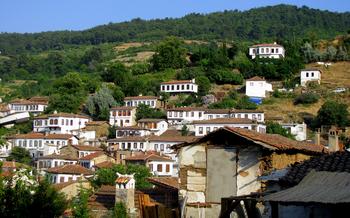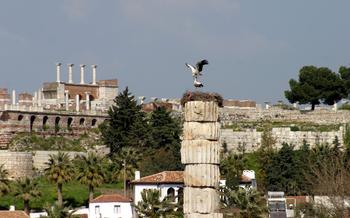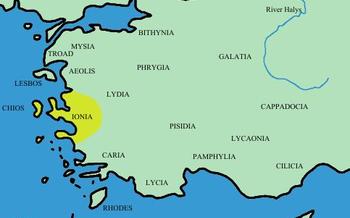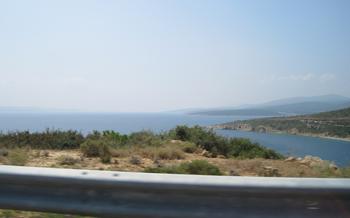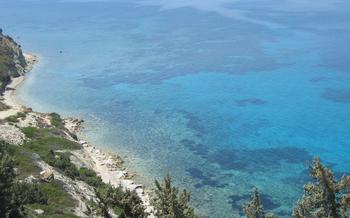
Çeşme Peninsula Vineyards and Wineries
- Çeşme Peninsula Vineyards and Wineries: A Perfect Getaway for Wine Enthusiasts
- Exploring the Çeşme Wine Region
- Top Wineries to Visit in the Çeşme Peninsula
- Grape Varieties of the Çeşme Peninsula
- Tasting the Wines of the Çeşme Peninsula
- Annual Grape Harvest Festival in the Çeşme Peninsula
- Festivities and Activities during the Festival
- Opportunities to Meet Winemakers and Learn About the Winemaking Process
- Tips for Planning a Trip to the Grape Harvest Festival
- Wine Tasting Tours in the Çeşme Peninsula
- Where to Stay in the Çeşme Peninsula
- Things to Do in the Çeşme Peninsula Beyond Wine Tasting
- Climate and Weather in the Çeşme Peninsula
- Transportation: Navigating the Çeşme Peninsula
- Shopping for Wine in the Çeşme Peninsula
- Customs and Regulations for Bringing Wine Back Home
- Insider Tip: Off-the-Beaten-Path Wineries
Çeşme Peninsula Vineyards and Wineries: A Perfect Getaway for Wine Enthusiasts
Winemaking in the Çeşme Peninsula dates back to ancient times, with evidence of viticulture in the region as early as the 1st century BC. The peninsula's unique terroir and climate, characterized by warm, sunny days, cool nights, and well-draining soils, make it an ideal location for growing grapes.
Over the centuries, the Çeşme Peninsula has become renowned for its diverse range of grape varieties, including native Turkish varieties such as Öküzgözü and Boğazkere, as well as international varieties such as Cabernet Sauvignon, Syrah, and Chardonnay. In recent years, the region has seen an influx of boutique wineries, each producing unique and exciting wines that showcase the potential of the Çeşme Peninsula.
Exploring the Çeşme Wine Region
The Çeşme Peninsula is home to several distinct wine regions, each with its own unique terroir and climate. The Urla region, located in the northern part of the peninsula, is known for its production of white wines, particularly Chardonnay and Sauvignon Blanc. The Alaçatı region, located in the western part of the peninsula, is known for its red wines, particularly Cabernet Sauvignon and Merlot. The Çeşme region, located in the southern part of the peninsula, is known for its rosé wines, particularly Kalecik Karası.
Urla: - Main Grape Varieties: Chardonnay, Sauvignon Blanc, Cabernet Sauvignon - Characteristics: The Urla region has a cool climate and well-drained soils, which are ideal for growing white grapes. The white wines produced in this region are typically crisp, refreshing, and aromatic.
Alaçatı: - Main Grape Varieties: Cabernet Sauvignon, Merlot, Syrah - Characteristics: The Alaçatı region has a warm climate and clay-rich soils, which are ideal for growing red grapes. The red wines produced in this region are typically full-bodied, rich, and complex.
Çeşme: - Main Grape Varieties: Kalecik Karası, Cabernet Sauvignon, Merlot - Characteristics: The Çeşme region has a moderate climate and sandy soils, which are ideal for growing rosé grapes. The rosé wines produced in this region are typically light-bodied, fruity, and refreshing.
Tips for planning a wine-tasting tour of the Çeşme Peninsula: - Choose the right time of year: The best time to visit the Çeşme Peninsula for wine tasting is during the spring or fall, when the weather is mild and pleasant. - Book your winery tours in advance: Many of the wineries in the Çeşme Peninsula are small and family-run, so it is important to book your tours in advance, especially if you are visiting during the peak season. - Plan your transportation: The Çeşme Peninsula is a large region, so it is important to plan your transportation in advance. You can rent a car, take a taxi, or join a wine-tasting tour. - Bring your passport: You will need to show your passport at each winery you visit, as the sale of alcohol is restricted in Turkey.
Top Wineries to Visit in the Çeşme Peninsula
The Çeşme Peninsula is home to a number of renowned wineries, each with its own unique history, winemaking philosophy, and signature wines. Here are a few of the top wineries that you should consider visiting:
-
Urla Winery: This winery is known for its award-winning Urla Chardonnay and Urla Cabernet Sauvignon wines. It offers a variety of wine-tasting experiences, including a tour of the winery and a tasting of its current releases.
-
Çeşme Bağları Winery: This winery is located in the heart of the Çeşme Peninsula and produces a wide range of wines, including red, white, and rosé. It offers a beautiful outdoor tasting room where you can enjoy a glass of wine while taking in the stunning views of the vineyards.
-
Buca Winery: This winery is known for its innovative winemaking techniques and its use of indigenous grape varieties. It offers a variety of wine-tasting experiences, including a tour of the winery and a tasting of its current releases.
-
Alaçatı Winery: This winery is located in the picturesque town of Alaçatı and produces a variety of wines, including red, white, and rosé. It offers a cozy tasting room where you can enjoy a glass of wine while learning about the winemaking process.
-
Şirince Winery: This winery is located in the historic village of Şirince and produces a variety of wines, including red, white, and rosé. It offers a variety of wine-tasting experiences, including a tour of the winery and a tasting of its current releases.
These are just a few of the many wineries that you can visit in the Çeşme Peninsula. Be sure to do some research and find the wineries that best suit your interests.
Grape Varieties of the Çeşme Peninsula
The Çeşme Peninsula is home to a diverse range of grape varieties, each contributing to the unique character and flavors of the region's wines. Among the most prominent varieties grown here are:
-
Çalkarası: A local variety known for its delicate floral aromas and crisp acidity. It is often used to make light-bodied, refreshing white wines.
-
Karasakız: Another indigenous grape, Karasakız produces deep-colored, full-bodied red wines with bold flavors and firm tannins.
-
Öküzgözü: A red grape variety that thrives in the warm climate of the Çeşme Peninsula. It is known for its intense ruby color and flavors of ripe red fruits, such as cherry and plum.
-
Boğazkere: A dark-skinned grape variety that produces wines with high tannins and a distinctive spicy character. It is often blended with other varieties to create complex and age-worthy red wines.
-
Cabernet Sauvignon: One of the most widely planted international varieties in the Çeşme Peninsula. It is known for its full-bodied structure, dark fruit flavors, and aging potential.
-
Merlot: Another popular international variety, Merlot produces softer, more approachable red wines with velvety tannins and flavors of red fruits, such as plum and black cherry.
-
Chardonnay: A versatile white grape variety that can produce a wide range of wines, from light and crisp to full-bodied and complex. In the Çeşme Peninsula, Chardonnay wines are known for their elegant flavors of citrus, green apple, and white peach.
-
Sauvignon Blanc: A crisp and refreshing white grape variety that produces wines with herbaceous aromas and flavors of citrus fruits, such as lime and grapefruit.
Tasting the Wines of the Çeşme Peninsula
The wines of the Çeşme Peninsula are known for their unique flavors and aromas, which are influenced by the region's terroir and climate. The peninsula's wines are typically characterized by their fruit-forward flavors, crisp acidity, and well-balanced tannins.
The Çeşme Peninsula produces a wide variety of wines, including reds, whites, and rosés. The most common grape varieties used in the region are Urla Karası, Çalkarası, Boğazkere, and Merlot.
Red wines from the Çeşme Peninsula are typically full-bodied and have flavors of red fruits, such as cherries, plums, and blackberries. They are often aged in oak barrels, which adds complexity and structure to the wines.
White wines from the Çeşme Peninsula are typically light-bodied and have flavors of citrus fruits, such as lemons and limes. They are often unoaked, which preserves their fresh and fruity flavors.
Rosé wines from the Çeşme Peninsula are typically light-bodied and have flavors of red fruits, such as strawberries and raspberries. They are often made from a blend of red and white grapes.
Çeşme wines are best paired with the region's cuisine, which is known for its fresh and flavorful dishes. Some popular food pairing suggestions include:
- Red wines with grilled meats, such as lamb chops or kebabs.
- White wines with seafood, such as grilled fish or shrimp.
- Rosé wines with salads, such as a traditional Turkish salad or a Greek salad.
When tasting Çeşme wines, it is important to pay attention to the following factors:
- Appearance: The wine should be clear and have a bright color.
- Aroma: The wine should have a pleasant aroma, with no off-putting smells.
- Taste: The wine should have a balanced flavor, with no one element overpowering the others.
- Finish: The wine should have a clean and lingering finish.
Annual Grape Harvest Festival in the Çeşme Peninsula
Held annually in September, the grape harvest festival is a vibrant celebration of the region's winemaking heritage. Visitors can immerse themselves in the festivities, which include grape stomping, wine tasting, live music, and traditional Turkish dancing.
Festivities and Activities during the Festival
The festival offers a variety of activities for visitors to enjoy. Highlights include:
- Grape stomping: Get your feet dirty and experience the traditional method of grape crushing.
- Wine tasting: Sample a wide range of wines from local wineries, including new releases and limited-edition vintages.
- Live music: Enjoy performances by local musicians and bands, creating a lively and festive atmosphere.
- Traditional Turkish dancing: Witness the grace and energy of Turkish folk dances, performed by talented local groups.
Opportunities to Meet Winemakers and Learn About the Winemaking Process
The festival provides an excellent opportunity to meet the winemakers behind the region's acclaimed wines. Engage in conversations, learn about their winemaking philosophies, and gain insights into the unique challenges and rewards of viticulture in the Çeşme Peninsula.
Tips for Planning a Trip to the Grape Harvest Festival
- Book your accommodation in advance: The festival attracts many visitors, so it's essential to secure your accommodation well in advance.
- Plan your transportation: If you're not driving, consider booking a shuttle or tour that will take you to and from the festival.
- Bring comfortable shoes: You'll be doing a lot of walking, so make sure to wear comfortable shoes.
- Stay hydrated: The weather can be hot during the festival, so drink plenty of water to stay hydrated.
- Be prepared for crowds: The festival can be crowded, so be prepared for long lines and lots of people.
Wine Tasting Tours in the Çeşme Peninsula
Joining a wine-tasting tour is an excellent way to experience the Çeşme Peninsula's wine scene without the hassle of planning and driving. Several tour operators offer various tours, ranging from half-day excursions to multi-day itineraries.
When choosing a wine-tasting tour, consider the following factors:
-
Tour operator's reputation: Read online reviews and ask for recommendations from friends or fellow travelers.
-
Tour itinerary: Make sure the tour visits wineries that interest you and offers activities that align with your preferences.
-
Group size: Smaller groups typically offer a more personalized experience, while larger groups may be more affordable.
-
Cost: Wine-tasting tours can vary in price depending on the duration, the number of wineries visited, and the inclusions (e.g., transportation, meals, tastings).
Based on my experiences, I highly recommend the following wine-tasting tour operators in the Çeşme Peninsula:
-
Çeşme Wine Tours: This local tour operator offers a range of half-day and full-day tours, including visits to boutique wineries, historical sites, and scenic viewpoints.
-
Grape Escapes: This tour operator specializes in small-group tours, led by knowledgeable guides who provide insights into the region's winemaking history and culture.
-
Vino Voyage: This tour operator offers customized itineraries, allowing you to tailor your tour to your specific interests and budget.
No matter which tour operator you choose, booking your tour in advance is recommended, especially during the peak season (June-September).
Where to Stay in the Çeşme Peninsula
When planning a trip to the Çeşme Peninsula, choosing the right accommodation is crucial for a comfortable and enjoyable stay. The region offers a wide range of options, from luxurious resorts and boutique hotels to cozy guesthouses and charming villas.
For those seeking a luxurious retreat, the Çeşme Hotel is an excellent choice. This five-star resort boasts stunning views of the Aegean Sea, private beaches, multiple restaurants, and a world-class spa.
For a more intimate experience, consider staying at one of the many boutique hotels in the region. The Bodrum Hotel is a charming property located in the heart of Çeşme, offering stylish rooms and suites, a rooftop terrace with panoramic views, and a cozy bar.
For budget-conscious travelers, there are several guesthouses and hostels that offer comfortable and affordable accommodations. The Çeşme Hostel is a popular choice among backpackers, featuring clean and basic rooms, a communal kitchen, and a friendly atmosphere.
For those seeking a unique and authentic experience, renting a villa is a great option. There are several beautiful villas available for rent in the Çeşme Peninsula, offering privacy, stunning views, and all the comforts of home.
No matter your budget or preferences, you're sure to find the perfect accommodation in the Çeşme Peninsula to make your wine-tasting trip truly memorable.
Things to Do in the Çeşme Peninsula Beyond Wine Tasting
While wine tasting is undoubtedly the main attraction of the Çeşme Peninsula, there are plenty of other activities and attractions to keep visitors entertained. History buffs can explore the ancient city of Erythrai, with its well-preserved ruins and artifacts. Culture vultures can visit the Çeşme Art Gallery, which showcases works by local and international artists. For those who love the outdoors, the peninsula offers a variety of hiking trails, bike paths, and water sports. Visitors can also take a boat trip to the nearby Greek islands of Chios and Samos. To make the most of your trip, plan a well-rounded itinerary that includes a mix of wine tasting, cultural exploration, and outdoor activities.
Climate and Weather in the Çeşme Peninsula
The Çeşme Peninsula enjoys a Mediterranean climate, characterized by hot, dry summers and mild, wet winters. The best time to visit the region for wine tasting is during the shoulder months (April-May and September-October), when the weather is pleasant and the crowds are smaller.
Average temperatures in the Çeşme Peninsula range from 10°C (50°F) in January to 28°C (82°F) in July. Rainfall is relatively low, with an average of only 500mm (20 inches) per year. The peninsula is also known for its strong winds, which can be a nuisance at times but also help to keep the air fresh and the vineyards healthy.
When packing for your trip to the Çeşme Peninsula, be sure to bring light, breathable clothing for the warm weather. You may also want to pack a jacket or sweater for the cooler evenings. Be sure to pack sunscreen, sunglasses, and a hat to protect yourself from the sun.
Transportation: Navigating the Çeşme Peninsula
Getting around the Çeşme Peninsula is a breeze, with several transportation options to choose from. If you prefer the freedom and flexibility of exploring at your own pace, renting a car is the best choice. Numerous car rental agencies are located at the Izmir Adnan Menderes Airport and in Çeşme town.
On the other hand, public transportation is a budget-friendly alternative. Buses connect Çeşme with major cities like Izmir and Bodrum, and within the peninsula itself. Buses are reliable and affordable, but they can be crowded during peak season.
Taxis are readily available, but they can be expensive, especially for longer distances. It's advisable to agree on a fare before getting in a taxi.
To visit the wineries, guided tours are a convenient option. Many tour operators offer wine-tasting tours that include transportation, allowing you to relax and enjoy the experience without worrying about driving.
No matter how you choose to get around, you'll find that the Çeşme Peninsula is well-connected and easy to navigate, ensuring a hassle-free wine-tasting adventure.
Shopping for Wine in the Çeşme Peninsula
If you're a wine lover, you'll be pleased to know that there are plenty of opportunities to purchase wine in the Çeşme Peninsula. You can find wine shops, wine bars, and even wineries that sell their own wines.
Here are a few tips for shopping for wine in the Çeşme Peninsula:
- Visit local wine shops: There are several wine shops in the Çeşme Peninsula where you can find a wide variety of wines from both local and international wineries. These shops are a great place to find unique and hard-to-find wines.
- Taste before you buy: Many wineries and wine shops offer wine tasting, so you can try before you buy. This is a great way to find wines that you like and to learn more about the different wine regions of the Çeşme Peninsula.
- Take advantage of duty-free shopping: If you're flying out of the Çeşme Peninsula, you can take advantage of duty-free shopping. This means that you can purchase wine without paying any taxes or duties.
- Pack your wine carefully: If you're bringing wine back home with you, be sure to pack it carefully. Wrap each bottle in bubble wrap or newspaper to prevent it from breaking. You should also pack your wine in a sturdy suitcase or box.
Customs and Regulations for Bringing Wine Back Home
Before leaving the Çeşme Peninsula, it's important to be aware of the customs regulations for importing wine into your home country. Each country has its own rules and regulations, so it's crucial to do some research before your trip. Generally, there are duty-free allowances for a certain amount of wine, but exceeding these limits may result in additional taxes or duties.
To avoid any problems at customs, it's advisable to keep your wine purchases within the duty-free limits. You should also declare any wine you're bringing back home on your customs form. Additionally, it's essential to pack your wine carefully to prevent breakage during the journey. Consider using protective packaging materials and sturdy containers to ensure your wine arrives home safely.
By following these tips, you can ensure a smooth and hassle-free experience when bringing Çeşme wines back home.
Insider Tip: Off-the-Beaten-Path Wineries
Beyond the renowned wineries that grace the Çeşme Peninsula, there lies a treasure trove of hidden gems waiting to be discovered by intrepid wine enthusiasts. These off-the-beaten-path wineries offer a unique glimpse into the region's rich winemaking heritage and showcase the passion and dedication of local winemakers.
To uncover these hidden gems, venture beyond the main wine routes and explore the charming villages and countryside that dot the peninsula. Engage with the locals, ask for recommendations, and be prepared for unexpected surprises. Some of these wineries may not have regular tasting rooms or guided tours, but the opportunity to connect with the winemakers themselves and taste their creations in an intimate setting is an experience that is well worth the effort.
One such hidden gem is the small, family-run winery of Bağcıoğlu Şarapçılık, nestled in the picturesque village of Alaçatı. Here, you'll find a warm welcome from the Bağcıoğlu family, who have been crafting wines for generations using traditional methods passed down from their ancestors. Their passion for winemaking is evident in every sip of their handcrafted wines, which showcase the unique terroir of the region.
Another hidden gem worth seeking out is Urla Şarapçılık, located in the heart of the Urla wine region. This boutique winery specializes in producing small batches of high-quality wines using sustainable viticultural practices. Their wines are a testament to the region's potential, showcasing the elegance and complexity that can be achieved in the Çeşme Peninsula.
For those seeking a truly unique experience, a visit to the underground winery of Kaya Şarapçılık is a must. Located in the village of Şirince, this winery has carved its cellars into the volcanic rock, creating a natural environment that perfectly complements the aging process of their wines. Their red wines, in particular, are known for their depth and complexity, reflecting the unique terroir of the volcanic soils.
These are just a few examples of the many hidden gem wineries that await discovery in the Çeşme Peninsula. Whether you prefer bold reds, crisp whites, or aromatic rosés, there's something for every palate among these off-the-beaten-path wineries. So, embrace your adventurous spirit, venture beyond the familiar, and uncover the hidden treasures of the Çeşme Peninsula wine region.
